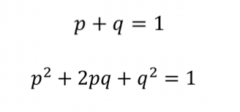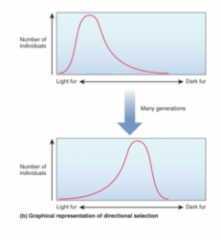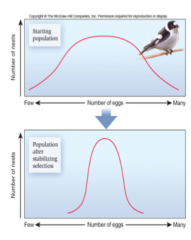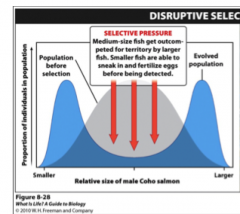![]()
![]()
![]()
Use LEFT and RIGHT arrow keys to navigate between flashcards;
Use UP and DOWN arrow keys to flip the card;
H to show hint;
A reads text to speech;
48 Cards in this Set
- Front
- Back
|
population genetics |
study of genes and genotypes in a population
seeks to know extent of genetic variation, why it exists, how its maintained, and how it changes over generations |
|
|
goal of population genetics |
to understand how genetic variation is related to phenotypic variation |
|
|
gene pool |
all of the alleles for every gene in a given population |
|
|
population |
group of same species that occupy same environment and can interbreed
often occupy wide geographic range divided into discrete populations |
|
|
characteristics of a healthy population |
large, and have a high level of genetic diversity allowing for natural selection |
|
|
polymorphism |
the presence of two or more variants or traits for a given character within a population |
|
|
polymorphic gene |
usually exists as two or more alleles in a population; most genes are this |
|
|
single nucleotide polymorphism (SNPs) |
the change/mutation of a single gene
smallest type of genetic change in a gene and most common
represents 90% of all variation in humans |
|
|
monomorphic gene |
exists predominantly as a single allele in a population; very rare |
|
|
how to calculate allele frequency |

be sure to remember that every individual has TWO alleles, so multiply the population size by two to get the total number of alleles |
|
|
how to calculate genotype frequency |

the genotype calls for the two alleles together, so divide that by the population size |
|
|
Hardy-Weinberg Equation |

relates alleles and genotype frequencies
p = allele 1 q = allele 2
p^2 and q^2 = homozygous
2pq = two ways to be heterozygous |
|
|
Hardy-Weinberg Equation purpose |
predicts that allele and genotype frequencies will stay the same for a non-evolving population
|
|
|
what is a non-evolving population for a h-w equation? |
1. no new mutations occur 2. no natural selection occurs 3. the population is so large that allele frequencies don't change due to chance 4. no migration occurs 5. random mating occurs between individuals in the population |
|
|
What is the frequency of pink flowers (CrCw) if the frequency of Cr is 0.4 and the population is in h-w equilibrium? |
p + q =1
0.4 + q = 1
q = 0.6
pink is heterozygous so... 2(0.4)(0.6) = 48% |
|
|
what does disequillibrium indicate in h-w equation? |
indicates evolution; a change in alleles and genotype frequencies |
|
|
microevolution |
changes in a population's gene pool from generation to generation |
|
|
two causes of microevolution |
1. new genetic variation (i.e. mutations, gene duplication, exon shuffling, horizontal gene transfer)
2. evolutionary mechanisms that alters the prevalence of an allele or genotype (i.e. natural selection, random genetic drift, migration, non random mating) |
|
|
all populations evolve and are affected by... |
natural selection, genetic drift, and non random mating |
|
|
adaptations |
changes in populations of living organisms that increase their ability to survive and reproduce in a particular environment |
|
|
natural selection |
beneficial, heritable traits that become more common in successive gens; resulting in adaptations |
|
|
fitness |
measure of reproductive success and its relatively likelihood that it'll contribute to the gene pool of the next generation |
|
|
two traits of reproductive success |
1. have better adaptations to their environment; therefore more likely to survive to reproductive age
2. may involve traits directly involved with reproduction |
|
|
principles of natural selection |
1. allelic variation arises from random mutations 2. some alleles encode proteins that enhance an individuals ability to survive or reproduce over others 3. beneficia alleles = more likely to survive 4. allele frequencies may change over time, often altering the characteristics of that population |
|
|
directional selection |

individuals at one extreme of a range have greater reproductive success in a particular environment |
|
|
initiators of directional selection |
1. new allele frequencies with higher fitness introduced
2. prolonged environmental change |
|
|
stabilizing selection |

favors the survival of individuals with intermediate phenotypes; extreme values are selected against (homozygosity) |
|
|
disruptive/diversifying selection |

favors the survival of two or more different phenotypes
likely to occur in heterogenous environments or when two phenotypes have a higher fitness |
|
|
balancing selection |
maintains genetic diversity with two or more alleles appearing roughly the same in a population |
|
|
balanced polymorphism |
two or more alleles are kept in balance and maintained in a population of many gens |
|
|
two ways balancing selection/polymorphism is maintained |
1. heterozygotes favored 2. negative frequency dependent selection |
|
|
negative frequency dependent selection |
rare individuals have a higher fitness, and live more until they become less rare in which the other one becomes rare... going on endlessly in a cycle |
|
|
sexual selection |
individuals with certain traits are more likely to engage in successful reproduction than others
typically effects males over females |
|
|
intrasexual selection |
one gender directly compete for mating opportunities or territories with the same gender |
|
|
intersexual selection |
occurs between members of the opposite sex; males usually have showy characteristics |
|
|
seuxal dimorphism |
a significant difference between the appearances between the two sexes within a species |
|
|
genetic drift |
changes allele frequency due to random chance; not fitness
favors the loss of fixation of an allele and occurs faster in smaller populations |
|
|
bottleneck effect |
environmental event that randomly eliminates members and the surviving members may have different allele frequencies from original population
lowers genetic variation |
|
|
founder effect |
smaller group separates from a larger population and the smaller pop will have less genetic variation and different allele frequencies from original population |
|
|
neutral theory of evolution |
"survival of the luckiest"
much of the variation is caused by genetic drift
usually is a 3 codon mutation |
|
|
neutral variation |
changes in genes and proteins that do not have an effect on reproductive success |
|
|
gene flow |
transfer of alleles into or out a population from migration |
|
|
migration |
the movement of individuals between population; increasing gene flow
enhances genetic diversity and reduce differences in allele frequencies for both populations |
|
|
non random mating |
the particular choosing of a mate |
|
|
disassortative mating |
dissimilar phenotypes mate preferentially; favors heterozygosity |
|
|
assortative mating |
similar phenotypes are more likely to mate; favors homozygosity |
|
|
inbreeding |
the mating of two genetically related individuals; increasing homozygosity and may have negative consequences with recessive alleles showing up in future gens
can lower the fitness of a population |
|
|
inbreeding dpression |
smaller population have a higher incidence of inbreeding, lowering reproductive success |

